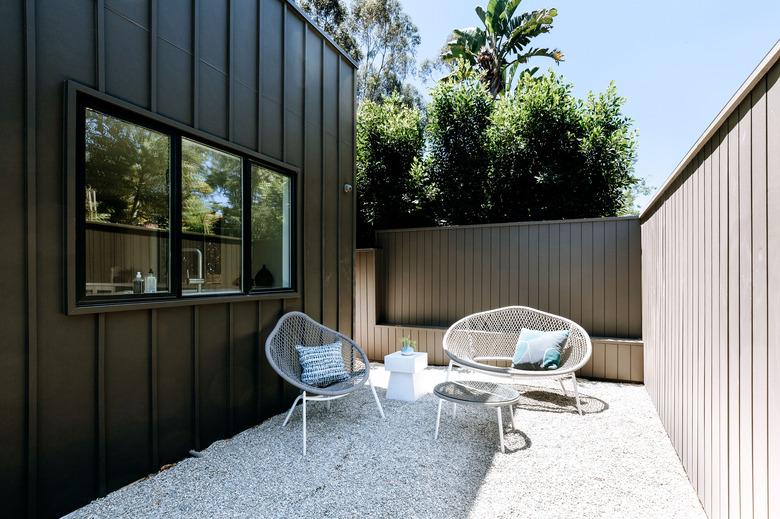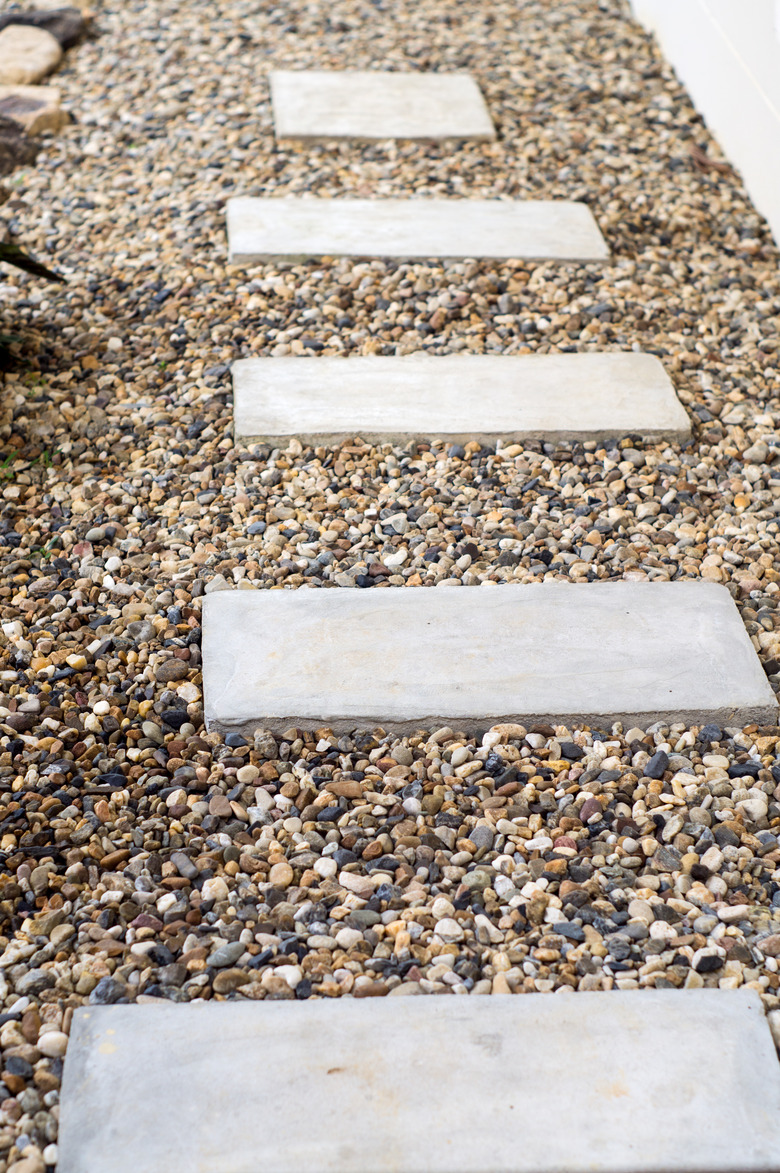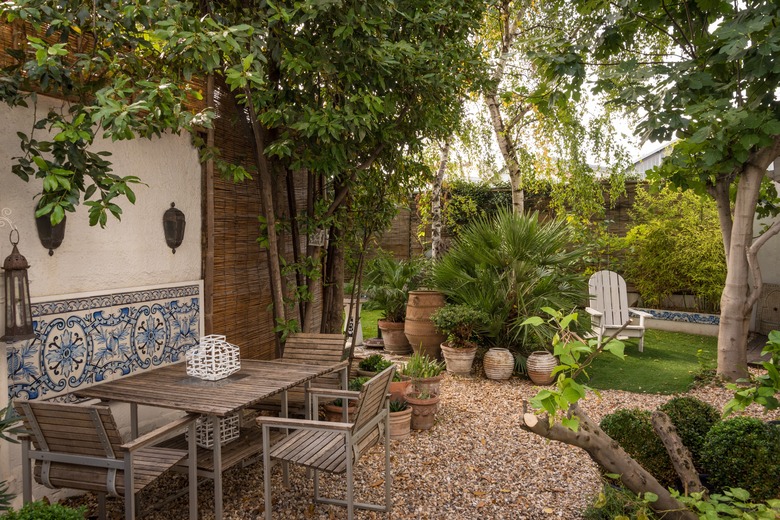What Is Pea Gravel And How Do You Use It?
Pea gravel is a decorative and useful landscaping material for mulching and making walkways, driveways and even patios. It's one of many types of gravel and is not to be confused with the angled gravel commonly used for drainage and underground structural construction. It behaves very differently, owing to its smooth round or oval-shaped stones. Unlike drainage gravel and crushed stone, pea gravel won't lock together to form a stable base, and when you use it as a mulch or hardscape material, you always have to confine it with some type of edging material, or you'll end up losing most of it.
Pea gravel is having quite the moment in landscape design—and despite the fact that it's a relatively inexpensive material, it's increasingly popping up in modern and show-stopping patios and landscaping.
Tip
Pea gravel is composed of river rock that has been smoothed and rounded. It has multiple decorative uses in landscaping—from mulching to pathways to modern looking patios.
Pea Gravel Is Basically River Rock
Pea Gravel Is Basically River Rock
Although it's probably possible to round the edges of angular gravel by putting it in a tumbler, most pea gravel is harvested from water beds, where it has been slowly smoothed and rounded by the elements. Because it's basically composed of river rock, pea gravel can take a variety of shapes, although most stones are generally round, oblong or triangular. Pea gravel comes in a range of colors including rust brown, white, gray and translucent depending on the types of minerals from which the rocks have formed.
Pea gravel is so-named because most of the stones are roughly the size and shape of a pea. Sizes range from 1/8 to 3/8 inch in diameter, but because the gravel has a natural source, there may be some larger stones mixed in. It's possible to find beach pebbles that range in size from 3/8 inch all the way to 4 and 5 inches, and these also make useful landscape material for mulch and decoration, but they aren't technically pea gravel, and they are usually filtered out.
Best Uses for Pea Gravel
Best Uses for Pea Gravel
Pea gravel is primarily an above-ground material and has few structural uses, although some landscapers use it in lieu of drain rock for bedding drain pipes and filling post holes, according to Ozinga. It's a decorative alternative to pavers or concrete for a garden path, a driveway or a patio, and because it doesn't deteriorate, it's a good mulch material with natural colors that add character to the garden.
Many DIY homeowners like pea gravel because it's easy to work into a landscape design, it's easy to install, it lasts a long time and it's relatively inexpensive. Pea gravel costs anywhere from $35 to $50 per cubic yard, according to the Gardening Channel, which compares favorably to wood decking or even concrete, which costs about $90 per cubic yard.
Pea gravel isn't without its drawbacks, the main one being its instability. Because the rocks have a smooth texture, they slip over one another rather than interlocking as angular gravel does, and they travel. Pea gravel isn't the best material to use on a slope, and even when used on a flat area, it needs an edging. It doesn't supply a very stable base for garden furniture, and pushing a wheelbarrow over it or shoveling snow from it can be challenging.
Where to Get Pea Gravel
Where to Get Pea Gravel
You can buy pea gravel in bags at any home supply outlet, but that isn't the best way to buy it, and you'll spend considerably more than you will if you get it in bulk. Most stone and gravel suppliers stock pea gravel and will deliver a truckload for a nominal extra charge, and you'll need a truckload for most large-scale projects. If all you want to do is mulch a small garden, however, a few bags may be all you need.
Making a Pea Gravel Walkway or Patio
Making a Pea Gravel Walkway or Patio
A layer of pea gravel needs a good, solid base, and if the ground is loamy or sandy, Braen Supply recommends laying a base layer of crushed gravel and tamping it down. The gravel layer should be 2 to 2 1/2 inches deep, and the pea gravel should also be layered to a depth of at least 2 inches (3 inches is better), so you need to dig out a bed to a depth of 4 to 5 inches to accommodate them. It isn't a good idea to lay pea gravel directly on the ground — the base rock helps hold the pea gravel in place and prevents it from being displaced, and a solid base also helps control weed growth.
Whether you install pea gravel on a base of crushed stone or directly on the ground, you need to install an edging to hold it in place. Common edging materials are:
- Wood or rubber bender board
- Plastic no-dig edging
- Concrete edgers
- Steel landscape edging
It's important to lay sheets of landscaping fabric under the pea gravel to control weeds that will displace the gravel and ruin its appearance if allowed to grow. Gardenista considers this optional if you have a base layer of crushed rock, but considering that gravel is porous and allows water to pass through, it's prudent to lay the fabric. If you're worried that it might be visible when the pea gravel gets displaced, lay it on the ground under the base rock.
Using Pea Gravel as Mulch
Using Pea Gravel as Mulch
When it comes to mulching, pea gravel has as many pros as it does cons. On the plus side, it adds color to enliven the garden, weeds have a hard time growing through it and it doesn't decompose. Even when using pea gravel in flower beds, a layer of landscaping fabric underneath it is recommended, and you ideally lay this before planting.
On the negative side, pea gravel retains heat, so it should only be used for plants that can tolerate high temperatures. It adds no nutrients to the soil, and it's difficult to remove should the time come for that. The small stones are also easily displaced from the flower beds and may end up in other parts of the lawn or get tracked into the house.
Pea Gravel Takes Little Maintenance
Pea Gravel Takes Little Maintenance
One of the best things about pea gravel is that it requires very little maintenance other than an occasional raking to smooth it out after a rainstorm. The small stones tend to settle after a few years, and if you have a pea gravel driveway, some of them will inevitably end up on the road, so you'll probably have to add more gravel periodically. You usually won't have to add more than a thin layer, though, so this is not a time-consuming or expensive chore.


